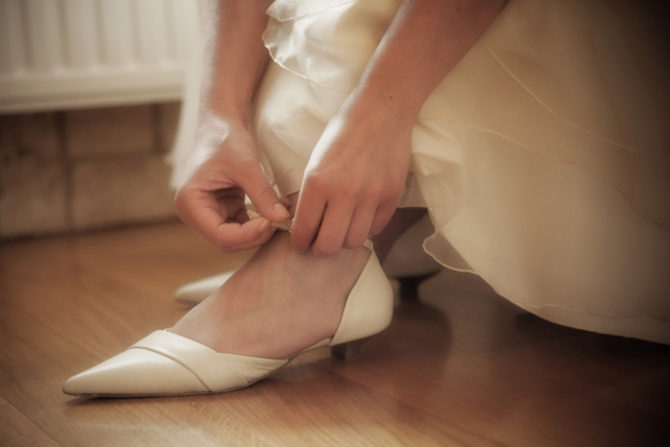Wedding etiquette in France


Gifts
If you are lucky enough to have been invited to a wedding in France this summer, or are planning to get married in France, you want the event to be memorable for the right reasons. Here are a few pointers on wedding and dining etiquette to avoid the most common faux pas!
Flowers
Generally white flowers are the choice for weddings, though some would hesitate at including white lilies as they are often used at funerals. Chrysanthemums of any colour are also the preserve of All Saint’s Day when the dead are remembered, so best avoided, and red carnations symbolise bad will. I got a very funny look from my florist when I asked for sunflowers and lavender for my bouquet – at the time, in that part of rural France, they were very much considered to be agricultural crops rather like carrying a bunch of broccoli! I was asked, in the tone of someone being very patient with a small child, if I wouldn’t rather have orchids! The florists did eventually concede though, and the bouquet looked amazing – non-French brides can probably get away with such “bizarre” notions!
Proceedings
The official civil marriage held in the town hall is usually a short affair, often only attended by a handful of close friends and relatives, and usually in the morning of the big day. There is usually then a longer religious ceremony in the afternoon which all guests attend, followed by a vin d’honneur drinks and nibbles party and then dinner, dessert and dancing into the small hours. The hosts may also offer a champagne breakfast the following morning. Expect then a long day (or two) of eating, drinking and entertainment! Which part of the day’s proceedings you are invited to depends on how well you know the couple – it is quite common for some guests to be invited for the religious ceremony and vin d’honneur and then only dessert and dancing (not the full dinner).
Table Manners
Even in average day-to-day situations French dinners are marathon events, so be prepared for the wedding banquet to be a seriously lengthy affair – up to six hours is not unheard of! As a result, and especially as getting wrecked right away is seriously frowned upon, you will want to pace yourself with the wine. Leaving your wine glass three quarters full will signal that you do not require any more. Other main table manners to note: it is considered very bad form to keep your hands in your lap at any time during the meal – keep elbows off the table but hands visible on the table; to indicate that you have finished eating simply place your knife and fork side by side on the plate; if you need to leave the table, but you are planning to come back to your meal, you should leave the napkin on your chair and not on the table – leaving the napkin on the table signals that you are finished.
Traditions
There are plenty of the usual sorts of traditions that you might observe in a French wedding – speeches, toasts, poem recitals and such. The cutting of a wedding cake is not necessarily a major feature at French weddings – indeed there might not even be a cake at all! However, this is changing and more and more French weddings will feature a tiered wedding cake. Also very popular, and thought of as a more typical French wedding cake, is the croquembouche – an outrageously delicious pyramid of caramel covered profiteroles! Another sweet tradition is to have prettily wrapped candy-covered almond favours called dragées to hand out to guests as a wedding keepsake. Mind you, I have also seen that this tradition too is changing amongst trendier types to offer chocolate bonbons, local specialities or even jelly beans instead of the sugared almonds. Lastly to note, it is now strictly forbidden to throw rice at the newly weds outside the town hall or the religious buildings – dried rose petals or biodegradable paper confetti is the norm.

As far as gifts are concerned, like elsewhere in Europe you will probably be presented with a wedding gift list with the invite – follow whatever instructions are in the invite as to where to purchase your gift. Having said that, as many more couples in France are now getting married having already moved in together, these gift lists are getting rarer – you may find that there is no list, so in that case it is best to enquire of the witnesses or the parents if there is a list or if there is to be a pot commun at the reception where you can discreetly place a cheque – you may even find that you are asked to donate to the couple’s favourite charity instead.
Attire
As you would expect, wearing white is a big no no (unless expressly specified in the invite). If you have been invited to the religious ceremony in a religious building, ladies should make sure to dress respectfully according to the religion. Finally bear in mind that it gets extremely hot in the summer here, especially in the South of France. On our special day, in late August, temperatures reached 40° by mid afternoon, forcing us to push proceedings back by an hour, and even then it was ridiculously hot. Brides are advised then to consider lighter, floatier fabrics, rather than heavily structured, tightly corseted, many petticoated concoctions – there is nothing chic about fainting in the middle of the vows! I would also advise against full morning suit for the groom; not only is the morning suit likely to elicit strange looks from the locals but also photos will be completely ruined with a red faced, sweating groom! Guests should also be encouraged to go for the less is more approach – hats aren’t obligatory, dress with the words “effortless, chic, quality” in mind. And if you are the hosts of this wonderful celebration, please make sure there is plenty of water on hand for guests who aren’t used to the high temperatures!
Vive les mariés!
Photo by Raphael Goetter
Share to: Facebook Twitter LinkedIn Email
More in champagne, events, garden, languedoc, renovation, summer, wine
By FrenchEntrée
Leave a reply
Your email address will not be published. Required fields are marked *




REPLY